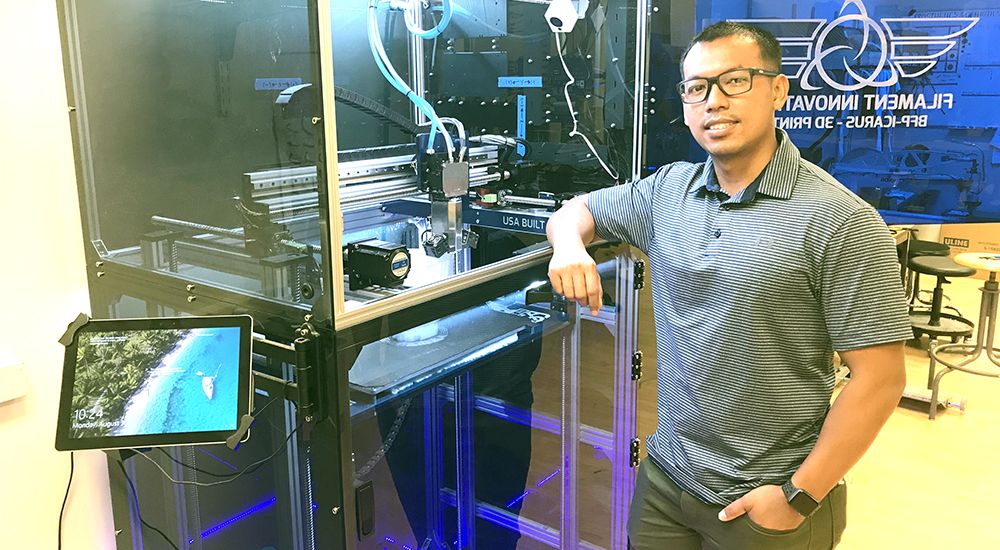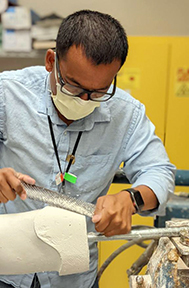Physical fitness is a way of life for California native, Marine Veteran, prosthetics artist and martial arts instructor Sopheara Kou. Kou’s passion for fitness and serving fellow Veterans would lead the way as he returned to his hometown following his service.
Upon his return to Long Beach, Kou started training in physical therapy, a field that closely aligned with his love of fitness. Through his training, Kou developed a deeper interest in prosthetics and orthotics and quickly shifted his career focus.
Graduating from California State University, Kou received offers for residencies in both orthotics and prosthetics with the Long Beach VA. Completing two years of residency and his training complete, Kou now serves Veterans full-time.
“VA training really helped me pass my certification exams and prepared me for being an effective and efficient full-time practitioner.”
Serving Veterans as a certified prosthetic orthotist, Kou develops a wide range of devices in terms of complexity. Some as simple as a shoe insert, others are used by athletes and Paralympians, which can be very intricate.
Kou is currently working on a running leg that requires an unconventional design where containment and stability exceed the capabilities of general models available today.
3D printing helps Veterans
He has also developed a multitude of other devices, such as above-and-below-the-knee prosthesis, upper extremity prosthesis and several types of braces, including spinal braces.
A leader in innovation, Kou pioneered 3D printing at the Long Beach VAMC and relies heavily on 3D printing technology as he develops new designs and features for fellow Veterans.
He is currently using 3D technology to develop prosthetic test sockets, which will help increase patient satisfaction.
“3D printing has really changed the practice of Orthotics and Prosthetics,” he said. “It helps our Veterans in ways we could not imagine before.”
National Prosthetics Week
October 4 through 8 is National Prosthetics and Sensory Aids Service Week. VA is the largest and most comprehensive provider of prosthetic devices and sensory aids in the world.
With products like artificial limbs, hearing aids, ramps and vehicle modifications, and devices that are surgically placed in the Veteran, such as hips and pacemakers, VA is providing comprehensive support that helps Veterans live healthier and more independent lives.
Learn about some of the amazing and innovative technology VA is using.
Learn more about the Office of Academic Affiliations
VA conducts its training programs for more than 120,000 health professions trainees annually. It works in affiliation with over 1,800 educational institutions across the country, including 97% of the United States’ medical colleges.
Find out more about OAA by visiting this website and by watching this video:
Topics in this story
More Stories
Study underscores important role COVID vaccination can have in protecting Veterans from infection and reducing long-term health consequences
Columbia VA’s robotic surgery teams completed their 800th robotic surgery and are on schedule to hit 1,000 by the end of the year.
In a decentralized clinical trial, Veterans can participate from their own homes or local VA instead of having to travel to a research site.








Nice work Kou
Kou is my Hero!!!
Wow, encouraging news. I’m a 74 year old Marine combat veteran who lost both legs high above-knee to an enemy IED in Vietnam in 1966. The trauma was extensive, leaving a real challenge to prosthetic development. I went through so many attempts with the VA over the years, trying to reach a point of success with functional bilateral prosthetics. I was a literal exercise in challenging development for extreme cases.. The last effort was in conjunction with Seattle VA and Hanger’s clinic in the Puget Sound in 2013-14. We came very close to reaching a degree of success, with the socket fitting still the challenge due to my irregular residual limbs.
I probably quit, then, which is not in my nature, but it seemed like we finally hit the wall, found the limits of my body, and my perseverance. I regret that a lot, still. So, to see efforts like this from a motivated and talented specialist, who also has some skin in the game as a Marine veteran, is very encouraging for veterans with similar circumstances as mine. For me, too late, but I hope some of the fails we experienced helped build a tiny bit of the history of prosthetic development, and helped lead to this new phase.
There will always be more severely wounded warriors, unfortunately; this nation STILL owes them the very best effort at restoring them for those sacrifices. (No other group in our American society gives their bodies to the nation’s safety and security, and even with veterans becoming a lower priority in that society now, the responsibility is still there, a contract signed in our own blood.)